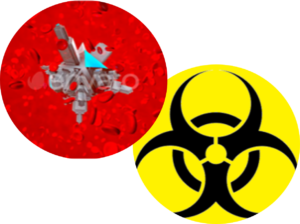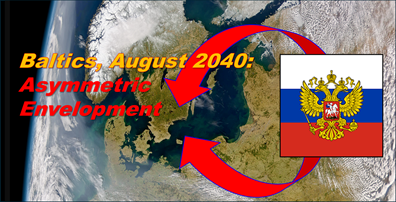[Editor’s Note: Crowdsourcing remains one of Army Mad Scientist’s most effective tools for harvesting ideas, thoughts, and concepts from a wide variety of interested individuals, helping us to diversify thought and challenge conventional assumptions about the Operational Environment.
 This Spring, we launched our Operational Environment Wicked Problems Writing Contest, seeking to explore how Twenty-first Century warfighting could evolve, given contemporary convergences of battlefield transparency, autonomous systems, and massed and precision fires that have resulted in an increasingly lethal Operational Environment. We asked our readers to address the following topic using either a non-fiction essay, a fictional intelligence (FICINT) story, or a submission incorporating a short FICINT vignette with an accompanying non-fiction essay expounding on the threat capabilities described in the vignette:
This Spring, we launched our Operational Environment Wicked Problems Writing Contest, seeking to explore how Twenty-first Century warfighting could evolve, given contemporary convergences of battlefield transparency, autonomous systems, and massed and precision fires that have resulted in an increasingly lethal Operational Environment. We asked our readers to address the following topic using either a non-fiction essay, a fictional intelligence (FICINT) story, or a submission incorporating a short FICINT vignette with an accompanying non-fiction essay expounding on the threat capabilities described in the vignette:
How have innovations in asymmetric warfare impacted modern large scale and other combat operations, and what further evolutions could take place, both within the next 10 years and on towards mid-century?
We were pleased to receive more than thirty contest submissions — a hearty “Thank you!” to all who took the time to cogitate on this topic, then craft and submit their insightful submissions for our consideration — “Well done!”
Today’s Mad Scientist Laboratory blog post features the winning submission by LTC Matt Rasmussen, who looks beyond today’s transformative capabilities with a cautionary tale, reminding us that all warfare is asymmetric. Our adversaries are constantly observing, probing, and adapting — striving to envelop whatever fleeting warfighting advantages we may yet devise — Read on!]
Baltics, August 2040: Asymmetric Envelopment
At first, it seemed as though the Ukraine War might revolutionize warfare. Militaries latched on to the novel technologies they had seen demonstrated; Artificial Intelligence (AI) and robotics began to be more and more ubiquitous in the late 2020s and early 2030s. With continuing improvements, autonomy for mass drones became easier and less cumbersome. Battery technology continued to improve, but drone swarms were still dependent on lots of power for communications, processing power, and control. Small drone range got better slowly. But when an exhausted Russia effectively stopped fighting in 2026 and Vladimir Putin suddenly died, the impetus for development slowed.
What did not slow down was the continued exploitation of the cyber domain. More and more systems were put on networks and so “script kiddies,” hacktivists, criminals, and radicals continued the wave of cyber activity and cybercrime kicked off by the COVID- 19 pandemic.1 More state-level actors began operating offensively in the cyber domain. Cyber conflict became the norm, so NATO established a combined joint cyber command in 2030. It was the “new normal” by 2040 for NATO countries to regularly attack and be attacked with cyber operations.2
 NATO cyber defenders were unsurprised when the daily briefing warned of increased Russian cyber-attacks on 23 August 2040. Indicators were high, but not different enough to interrupt the daily “mowing the lawn” of offensive cyber counterattacks.
NATO cyber defenders were unsurprised when the daily briefing warned of increased Russian cyber-attacks on 23 August 2040. Indicators were high, but not different enough to interrupt the daily “mowing the lawn” of offensive cyber counterattacks.
Gotland Island in the Baltic Sea now housed many of the forward sensor arrays for part of NATO’s Baltic Reconnaissance-Strike Complex (BRSC).3 The BSRC was a networked, integrated set of sensors, missiles, artillery, and naval and air forces linked into the greater NATO kill-web. The idea of each Reconnaissance-Strike Complex was to create a standing combined joint task force with every sensor, drone swarm, ship, missile, and aircraft under one commander who could fight at standoff.4 This would make up much of the shortage in ground and naval forces caused by poor recruitment and lack of industrial investment. Russia created an equivalent to the RSCs, too — they called them “разведывательно-ударный комплекс” (PYK). Untested but impressive, NATO drilled RSC forces in much the same way that the Strategic Air Command drilled the nuclear Single Integrated Operational Plan. Russia’s Eastern PYK stared back at NATO across the Baltic from Kaliningrad.
The concept was that in a crisis, a NATO RSC would seize the initiative by rapidly pulling in all the satellite, drone, autonomous aircraft, and sensor data in the Joint Operations Area (JOA) to create AI-enabled firing solutions with an optimal mix of targets. All member countries would simply feed their capabilities forward into the zone and the RSC would create AI generated traffic patterns, Air Tasking Orders, bed down locations, and logistic plans to allow the human staff time to start generating future options.5

No one had paid much attention to the Russian ship as it left St Petersburg on 21 August — a large container ship with cargo containers stacked high. When the crew issued a mayday on 22 August near Gotland and began to drift, the Swedish Coast Guard responded. The crew reported their navigation systems were out. On 23 August, the ship drifted rapidly and dangerously close to the shore and eventually careened into the land not far from the main NATO sensor array for the BSRC. It was a small story on major news outlets.
 On 24 August, most NATO capitals and headquarters were hit by a massive wave of distributed denial-of-service (DDoS) attacks, far greater than normal, using a variety of means from a variety of actors.
On 24 August, most NATO capitals and headquarters were hit by a massive wave of distributed denial-of-service (DDoS) attacks, far greater than normal, using a variety of means from a variety of actors.
NATO Cyber went on the offensive, shutting down about 60% of the attackers over the course of the day. Public affairs representatives prepared angry remarks about the (presumed) Russian sponsored attacks. In situation rooms throughout Europe and the US, military and political leaders considered their response to these unprecedented attacks. The Russians denied everything, but the evidence was clearly there. In hindsight, it seems clear that the Russians wanted us to know they had clouded the cyber domain with a massive attack. They weren’t subtle about it; they wanted us to think we were looking the right way.
On 25 August, the containers on the Russian ship on Gotland suddenly began to slide off the deck and start degrading rapidly, seemingly breaking down into fine particles.
 At NATO headquarters in Brussels, an autonomous truck crashed by the perimeter fence, spilling barrels of a fine, sticky substance that seemed to pick up and blow in the wind towards the buildings, even though it was a calm day.
At NATO headquarters in Brussels, an autonomous truck crashed by the perimeter fence, spilling barrels of a fine, sticky substance that seemed to pick up and blow in the wind towards the buildings, even though it was a calm day.
In Copenhagen, Gdansk and Gdynia, Tallinn, and Karlskrona, Russian container ships slammed into port facilities by accident. Some were able to physically block the ports, and all seemed to lose their poorly lashed down cargo.6 Everywhere, the fine particles seemed to fly off containers or vehicles, into the air and water.
 The faintly visible particles weren’t just dirt, dust, or rust. They were something no one expected: synthetic biological agents. In the water, micromotors on nano-microswimmers launched off.7 These carried bioengineered enzymes specifically manufactured to eat plastic and metal.8 In the air, nanoparticle swarms flew using artificial replication of biological organisms. In each case, these water and airborne nanoparticles were engineered to respond to electromagnetic energy9 —the same kind emitted by the RSC transmitters fitted on every NATO ship, missile, and vehicle in the Baltic.10 Others were engineered to seek out specific metals and plastics.
The faintly visible particles weren’t just dirt, dust, or rust. They were something no one expected: synthetic biological agents. In the water, micromotors on nano-microswimmers launched off.7 These carried bioengineered enzymes specifically manufactured to eat plastic and metal.8 In the air, nanoparticle swarms flew using artificial replication of biological organisms. In each case, these water and airborne nanoparticles were engineered to respond to electromagnetic energy9 —the same kind emitted by the RSC transmitters fitted on every NATO ship, missile, and vehicle in the Baltic.10 Others were engineered to seek out specific metals and plastics.
 Yet another kind of nanoparticle attacked biologicals. These particles dispersed in the air and clustered in air vents, throats, and lungs. Engineered with synthetic biology, they acted as targeted bioweapons. They infiltrated the respiratory systems of personnel, causing debilitating illnesses that spread rapidly through the ranks.11
Yet another kind of nanoparticle attacked biologicals. These particles dispersed in the air and clustered in air vents, throats, and lungs. Engineered with synthetic biology, they acted as targeted bioweapons. They infiltrated the respiratory systems of personnel, causing debilitating illnesses that spread rapidly through the ranks.11
At bases across Eastern Europe, more accidents started happening, spilling more and more nano-bio weapons near BSRC sensors, weapons, and personnel.
At the BSRC headquarters, a message came in via multiple means: “Hello NATO, the Baltic is closed to your traffic. There is a line of nano-biosensors across the Kattegat and Skagerrak, which are linked to a fleet of autonomous surface vehicles standing by behind them. Any approach through this area will be defeated.”
 Later evidence showed that the Russians enabled these attacks with a sophisticated network of Brain-Computer Interfaces (BCIs) to augment their cyber and physical attacks. Russian operatives, equipped with BCIs, were able to achieve unprecedented levels of coordination and efficiency. These interfaces allowed operators to synchronize multiple systems simultaneously through thought alone, speeding up response times and enhancing multi-tasking capabilities.12
Later evidence showed that the Russians enabled these attacks with a sophisticated network of Brain-Computer Interfaces (BCIs) to augment their cyber and physical attacks. Russian operatives, equipped with BCIs, were able to achieve unprecedented levels of coordination and efficiency. These interfaces allowed operators to synchronize multiple systems simultaneously through thought alone, speeding up response times and enhancing multi-tasking capabilities.12
Just before midnight on 25 August 2040, air raid sirens in Latvia, Estonia, and Lithuania began to go off as the first wave of Russian missiles rocketed toward their targets.
***
Seventy-two hours later, a grim-faced NATO Military Deputy walked into the North Atlantic Council meeting in NATO Headquarters.
 “Ladies and Gentlemen, the situation is grave. Russian conventional forces have nearly completed their conquest of Latvia, Estonia, and Lithuania. As you know, after the events of the 25th, and the mass confusion that ensued, the Russian Army stormed across those borders in force in a race to the Baltic Sea.”
“Ladies and Gentlemen, the situation is grave. Russian conventional forces have nearly completed their conquest of Latvia, Estonia, and Lithuania. As you know, after the events of the 25th, and the mass confusion that ensued, the Russian Army stormed across those borders in force in a race to the Baltic Sea.”
“The cyber-attacks were a smokescreen that concealed their main supporting effort. Those were the deceptive physical infrastructure attacks camouflaged as accidents, paired with nanotech and bioengineered mechanisms. Rather than going missile on missile, drone on drone, the Russians attacked the  sensors, data links, transmitters, and C2 nodes of the RSC. Now our local counterattacks against Russian assets by the BSRC commander over the last three days have been piecemeal, without mass and synchronization.”
sensors, data links, transmitters, and C2 nodes of the RSC. Now our local counterattacks against Russian assets by the BSRC commander over the last three days have been piecemeal, without mass and synchronization.”
“The Baltic RSC has been reduced to 33% effectiveness. Sweden and Finland’s air assets have been reduced by 50%. Poland, Denmark, Sweden, and Finland’s naval assets are operating at near 10% of original capacity. Most of their fleets are disabled from nano-bio attacks in their main port facilities. Additionally, Russian “accidental” ship mishaps have shut down ports and port facilities throughout the Baltic.”
 “Russian political demands are non-interference in their operations in the three Baltic republics and broad demilitarization across of the Baltic region. Reinforcements to the Baltic republics from the US and Western Europe have been interrupted by cyber-attacks and fears that the nano-bio weapons have infected Aerial Ports of Debarkation (APODs) in Western Europe and Poland. We have no effective defense or clean up tool to counter these weapons. Russian conventional strikes have disabled every Sea Port of Debarkation (SPOD) and APOD in the three Baltic republics, making reinforcement problematic in any case.”
“Russian political demands are non-interference in their operations in the three Baltic republics and broad demilitarization across of the Baltic region. Reinforcements to the Baltic republics from the US and Western Europe have been interrupted by cyber-attacks and fears that the nano-bio weapons have infected Aerial Ports of Debarkation (APODs) in Western Europe and Poland. We have no effective defense or clean up tool to counter these weapons. Russian conventional strikes have disabled every Sea Port of Debarkation (SPOD) and APOD in the three Baltic republics, making reinforcement problematic in any case.”
He paused and drew a breath, “We thought we were the ‘first follower’ to build the best ‘Kill-Web’. But the Russians built a mirror image Potemkin village called PYK and then did an end-run around our best weapon. Whatever happens next will be a long, hard slog. Conrad Crane once famously said, ‘there are two types of warfare: asymmetric and stupid.’ 13 He paused for a moment. “At some point, cyber, AI, robotics, and swarming tech all seemed new and different and undefeatable. I guess we counted on the Russians fighting stupid….”
If you enjoyed this post, explore the TRADOC G-2‘s Operational Environment Enterprise web page, brimming with information on the Operational Environment and how our adversaries fight, including:
Our China Landing Zone, full of information regarding our pacing challenge, including ATP 7-100.3, Chinese Tactics, BiteSize China weekly topics, People’s Liberation Army Ground Forces Quick Reference Guide, and our thirty-plus snapshots captured to date addressing what China is learning about the Operational Environment from Russia’s war against Ukraine (note that a DoD Common Access Card [CAC] is required to access this last link).
Our Russia Landing Zone, including the BiteSize Russia weekly topics. If you have a CAC, you’ll be especially interested in reviewing our weekly RUS-UKR Conflict Running Estimates and associated Narratives, capturing what we learned about the contemporary Russian way of war in Ukraine over the past two years and the ramifications for U.S. Army modernization across DOTMLPF-P.
Our Running Estimates SharePoint site (also requires a CAC to access), containing our monthly OE Running Estimates, associated Narratives, and the 2QFY24 and 3QFY24 OE Assessment TRADOC Intelligence Posts (TIPs).
Read the following Army Mad Scientist related content:
The Operational Environment’s Increased Lethality
Realer than Real: Useful Fiction and associated podcast, with proclaimed Mad Scientists P.W. Singer and August Cole
Insights from Ukraine on the Operational Environment and the Changing Character of Warfare
Rise of Artificial Intelligence: Implications to the Fielded Force, by John W. Mabes III
Insights from the Robotics and Autonomy Series of Virtual Events
Revolutionizing 21st Century Warfighting: UAVs and C-UAS
The Future of War is Cyber! by then CPT Casey Igo and CPT Christian Turley
The Last Frontier, by then PFC Peter Brenner
Check out the following Mad Scientist Laboratory content crowdsourced from previous writing contests:
The Future of the AI Battlefield:
Takeaways Learned about the Future of the AI Battlefield
The Guy Behind the Guy: AI as the Indispensable Marshal, by Brady Moore and Chris Sauceda
The Human Targeting Solution: An AI Story, by CW3 Jesse R. Crifasi
Back to the Future:
Task Force Wolf, by proclaimed Mad Scientist LTC Daniel Gomez
The Operational Environment: What Will Change and What Will Drive It – Today to 2035?
Splinternets, by proclaimed Mad Scientist Howard R. Simkin
The Operational Environment in 2035 Writing Contest:
Louisiana Maneuvers for the Age of Artificial Intelligence, by proclaimed Mad Scientist MAJ Michael B. Kim
The Information Disruption Industry and the Operational Environment of the Future, by proclaimed Mad Scientist Vincent H. O’Neil
Military Implications of Smart Cities, by Alexander Braszko, Jr.
Information Warfare Vignettes Writing Contest:
Three Best Information Warfare Vignettes, by proclaimed Mad Scientist Davis Ellison, Tony Stark, and Rob Kunzig
Competition, Crisis, Conflict, and Change Writing Contest:
The U.S. Joint Force’s Defeat before Conflict, by proclaimed Mad Scientist CPT Anjanay Kumar
A House Divided: Microtargeting and the next Great American Threat, by 1LT Carlin Keally
CALLING ALL CREATORS ~ An Army Mad Scientist Multi-Media Contest:
Kryptós, by proclaimed Mad Scientist CPT Katherine Hathaway
2nd Dense Urban Armored Brigade (DUAB) Personnel Evaluations, by Ed dos Santos, Jr.
Fall / Winter 2021 Writing Contest:
OASIS: A North American Proving Ground, by proclaimed Mad Scientist Steve Pomper
The Army’s Next Failed War: Large Scale Combat Operations, by proclaimed Mad Scientist MAJ Anthony Joyce
On Surprise Attacks Below the “Bolt from the Blue” Threshold, by Lesley Kucharski
About the Author: Matt Rasmussen is a U.S. Army Infantry officer who currently serves as an Assistant Professor and Course Director at the U.S. Army War College. In addition to the regular curriculum, Matt teaches and advises in the “Futures Seminar” special program, guiding students through a future forecasting process to answer questions for senior DoD decision makers.
Disclaimer: The views expressed in this blog post do not necessarily reflect those of the U.S. Department of Defense, Department of the Army, Army Futures Command (AFC), or Training and Doctrine Command (TRADOC).
1 Chart: Cybercrime Expected To Skyrocket in Coming Years | Statista; The U.S. Is Less Prepared to Fight Cybercrime Than It Could Be | U.S. GAO; Rising Cyber Threats Pose Serious Concerns for Financial Stability (imf.org)
2 The Proliferation of Offensive Cyber Capabilities – Atlantic Council; The New “Cyber” Space Race: Integrating the Private Sector Into U.S. Cyber Strategy > National Defense University Press > Article (ndu.edu)
3 Gotland: NATO’s Baltic Bastion – CEPA
4 Sponsored Content | Campaigning Through the WEZ: CJADC2 Is More than Kill-Chains (usni.org), Emerging and Disruptive Technologies in Defence (thegeostrata.com); Adapting Cross-Domain Kill-Webs (darpa.mil); Creating a ‘kill web’: Army brings other services, allies together to test new tech for a major fight | The American Legion
5 MIT gives AI the power to ‘reason like humans’ by creating new hybrid AI architecture | Live Science, AI chatbots are bad at planning, but this could soon change (theconversation.com)
6 The Baltimore Bridge Collapse Is Also a National Security Problem | RAND
7 Designing Micro- and Nanoswimmers for Specific Applications | Accounts of Chemical Research (acs.org)
8 We are just getting started’: the plastic-eating bacteria that could change the world | Plastics | The Guardian
9 Remote-controlled nanoparticles could fight cancer — gently (snexplores.org)
10 Exploring the ultrasmall and ultrafast through advances in attosecond science (phys.org)
11 Toxics | Free Full-Text | Nanoparticles: Excellent Materials Yet Dangerous When They Become Airborne (mdpi.com)
12 Sensors | Free Full-Text | State-of-the-Art on Brain-Computer Interface Technology (mdpi.com)
13 Asymmetry Is Strategy, Strategy Is Asymmetry > National Defense University Press > News Article View (ndu.edu)



